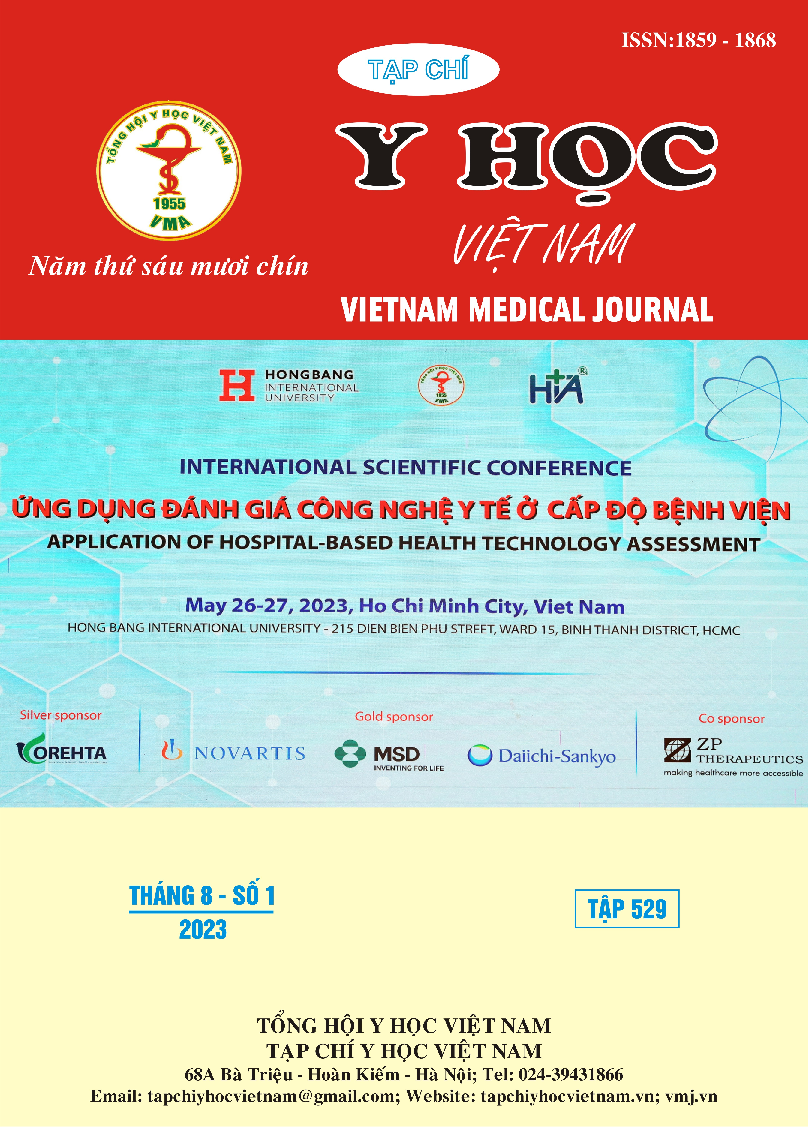THE ROLE OF THE BRAF V600E MUTATION IN THE CONVENTIONAL PAPILLARY THYROID CARCINOMA
Main Article Content
Abstract
Background: BRAF V600E mutation is often detected in papillary thyroid carcinoma. However, it is still controversial whether or not it is associated with the prognosis of papillary thyroid carcinoma. Objectives: (1) To describe the rate of BRAF V600E mutation in conventional papillary thyroid carcinoma by using Sanger sequencing. (2) To describe the association between this mutation and age, gender, and macroscopic and microscopic features. Methods: 38 cases with conventional papillary thyroid carcinoma which underwent manual macro-dissection to determine BRAF gene mutation status by Sanger sequencing. Reverse prognostic factors in papillary thyroid carcinoma including microscopic extrathyroidal invasion, histopathology, chronic thyroiditis, and lymph node metastasis were independently evaluated by two pathologists. Inconsistent features should be consulted with a pathologist experienced in the diagnosis of thyroid pathology. Other prognostic factors such as macroscopic extrathyroidal invasion, tumor size, age and gender were recorded from the electronic medical record system at Department of Pathology, University Medical Center at Ho Chi Minh city. Results: The prevalence of BRAF mutations in conventional papillary thyroid carcinoma was 81.6% and all were BRAF V600E mutations. The mutation was associated with female gender (p < 0.01), no gross extrathyroidal invasion (p < 0.01) and was not associated with tumor size, multifocal status, extrathyroidal invasion microscopic thyroid and lymph node metastasis (p > 0.05). Conclusions: Conventional papillary thyroid carcinoma had a BRAF V600E mutation rate of 81.6%. This mutation was not related to factors of tumor growth such as tumor size, multifocality, extrathyroidal extension as well as extrathyroidal growth factors such as lymph node metastasis. These findings support the hypothesis that BRAF V600E is an oncogenic mutation rather than an independent prognostic factor in papillary thyroid carcinoma.
Article Details
Keywords
papillary thyroid carcinoma, tall cell variant, BRAF V600E, prognostic factor
References
2. Gandolfi G, Sancisi V, Torricelli F, Ragazzi M, Frasoldati A, et al. (2013), "Allele percentage of the BRAF V600E mutation in papillary thyroid carcinomas and corresponding lymph node metastases: no evidence for a role in tumor progression". The Journal of Clinical Endocrinology & Metabolism, 98(5), pp. E934-E942.
3. Hu A, Clark J, Payne RJ, Eski S, Walfish PG, et al (2007), "Extrathyroidal Extension in Well-Differentiated Thyroid Cancer: Macroscopic vs Microscopic as a Predictor of Outcome". Archives of Otolaryngology–Head & Neck Surgery, 133 (7), pp. 644-649
4. Ito Y, Yoshida H, Maruo R, Morita S, Takano T, et al (2009), "BRAF mutation in papillary thyroid carcinoma in a Japanese population: its lack of correlation with high-risk clinicopathological features and disease-free survival of patients". Endocrine journal, 56(1), 89-97.
5. Kakudo K, Bychkov A, Bai Y, Li Y, Liu Z, et al., The new 4th edition World Health Organization classification for thyroid tumors, Asian perspectives, 2018, Wiley Online Library.
6. Ngô Thị Minh Hạnh và cs (2020): Giá trị của hoá mô miễn dịch biểu lộ BRAF V600E(VE1) trong ung thư biểu mô tuyến giáp thể biệt hoá tái phát, di căn. Tạp Chí Y Học Việt Nam, số 497, 72-78.
7. Nikiforova MN, Kimura ET, Gandhi M, Biddinger PW, Knauf JA, et al (2003), "BRAF mutations in thyroid tumors are restricted to papillary carcinomas and anaplastic or poorly differentiated carcinomas arising from papillary carcinomas". J Clin Endocrinol Metab, 88(11), 5399-404.
8. Xing M et al (2005), "BRAF mutation in thyroid cancer". Endocr Relat Cancer, 12(2), 245-62.7


